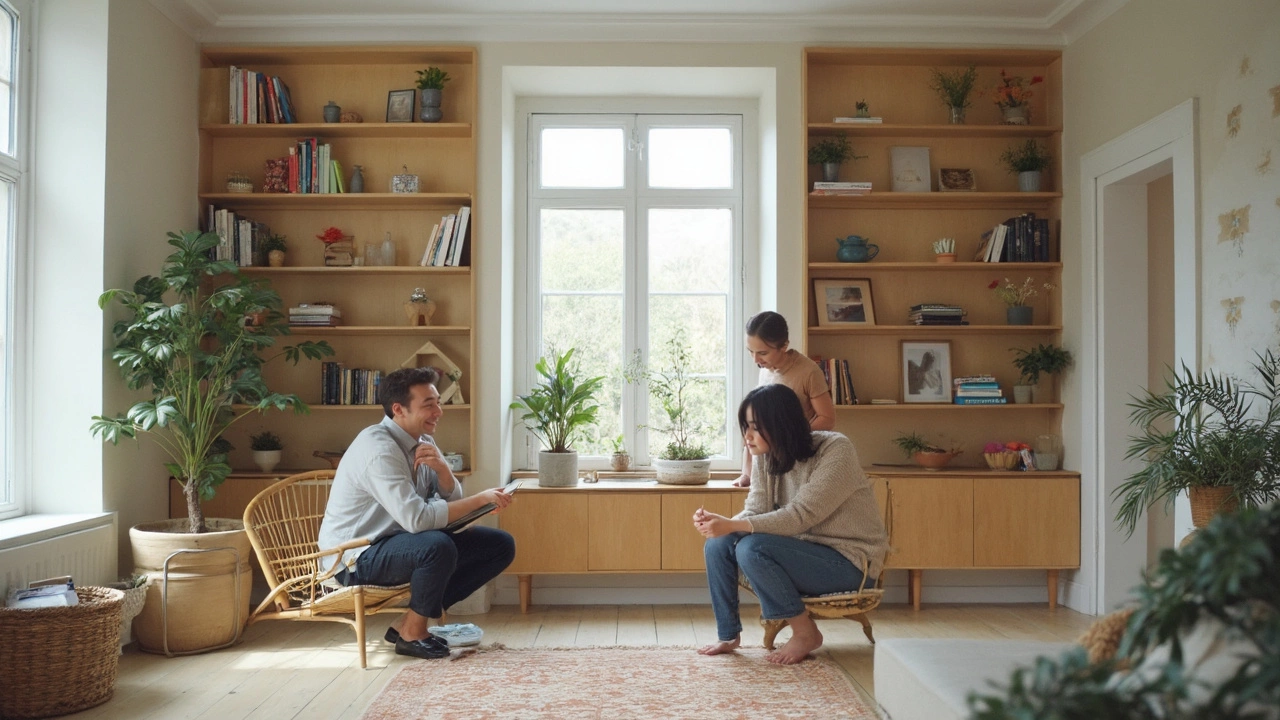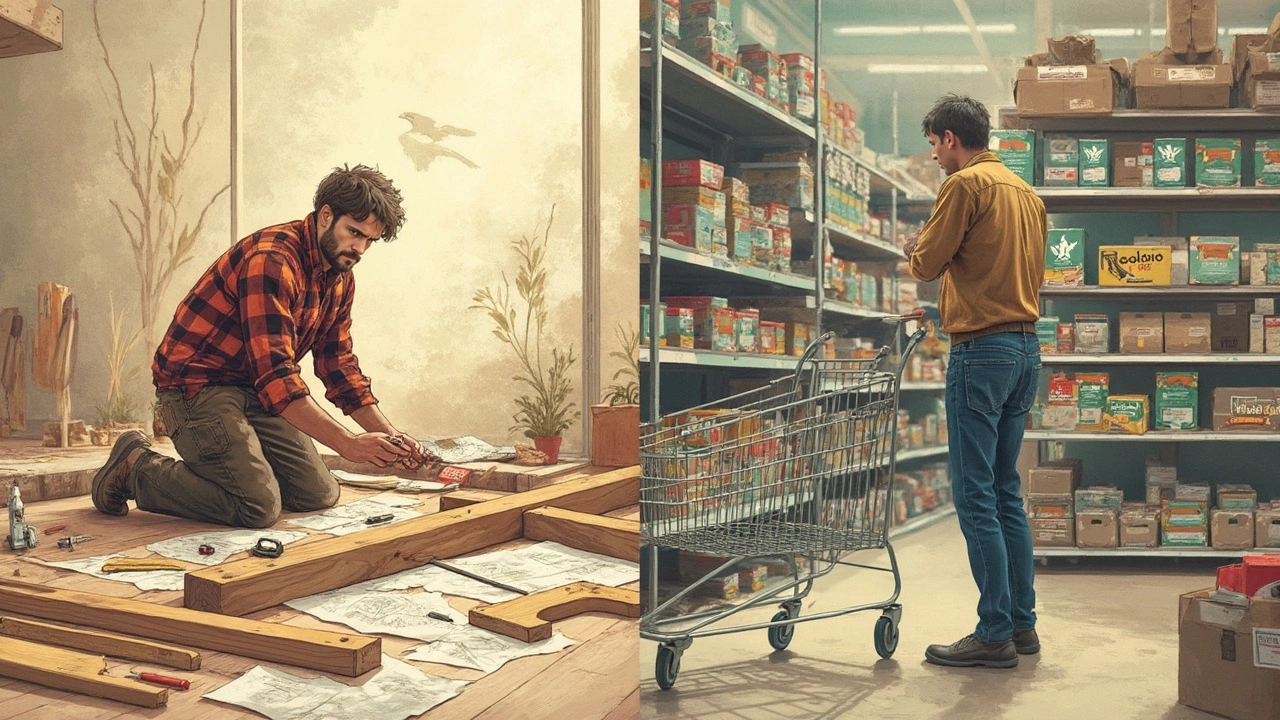Is It Cheaper to Buy Shelves or Make Them? The Real Costs Explained
 May, 27 2025
May, 27 2025
People love the idea of saving a few bucks by making stuff themselves, but does DIY shelving actually beat store prices once you add up everything? The answer isn’t always what you’d think. Sure, the ad says you can snag a shelf for $25, but we all know those are usually tiny, wobbly, or just ugly.
Grab a calculator, because there's more at play: wood isn’t cheap, and screws, paint, or brackets add up. And unless you have a well-equipped garage already, buying just one power tool can double your entire project cost. Plus, not all DIY projects go according to plan—a crooked cut can mean wasted boards, and fixes eat into any savings fast.
- Breaking Down the Costs: Store-Bought vs. DIY
- Materials and Tools: What DIY Really Takes
- Time and Skill: The Hidden Price Tags
- When Building Wins (and When It Doesn't)
Breaking Down the Costs: Store-Bought vs. DIY
If you’re staring at a shelf online or at the hardware store, you’ll usually see a price tag anywhere from $20 for a basic unit up to $300 for something fancier or with hardwood. Big brands like IKEA, Home Depot, and Target offer a lot of options, but most of their shelves are made with particle board or MDF, not real wood. That matters for both price and how long they last.
Now, say you want to make a basic wall shelf at home. For a 3-foot-wide solid pine shelf, the wood alone can cost $15–$35 as of early 2025. Add in $5–$10 for brackets, another $3 for screws, and maybe $8 for a small can of stain. That’s $30 to $55 before you even count your time or the cost of tools. If you don’t already have a saw, drill, or sander, those could add $30–$60 each, even for the basic entry-level tools. Suddenly, your “cheap” project costs about the same as a ready-made shelf—sometimes more.
Here’s a quick way to compare:
- Buy shelves: Pay for convenience, get a set look, spend 15 minutes installing. Limited in size and finish unless you pay big.
- DIY shelves: Custom fit, pick your wood, choose your color, but you invest time and deal with possible mistakes. Savings only show up if you reuse tools, buy materials in bulk, or make several shelves at once.
According to a report by Consumer Reports, "For most simple shelving units under 4 feet, DIY projects only start to save money if you already own the tools and are building three or more."
"If you’re just doing one or two shelves and starting from scratch, buying is almost always cheaper in the short run." - Consumer Reports, 2024
So for most people, unless you’re filling a whole wall or trying to match a weird space, buy shelves is the wallet-friendly choice. If you want custom or high-quality, building makes sense—but only if you’re okay putting in the work and already have some gear at home.
Materials and Tools: What DIY Really Takes
If you’re thinking about building shelves yourself, the first thing to pin down is what you actually need to buy. It's not just boards and a hammer—there’s more to it than people expect. Let’s break down the basics and some stuff most DIY-ers wish they knew before swiping their card.
The biggest chunk of your cost is always shelving material. Pine and plywood are go-tos for budget folks, while oak and walnut look cooler but cost way more. A standard 8-foot 1x12 pine board runs about $18 right now. You’ll need a couple, even for a small wall shelf. Add brackets—those cheap metal L-brackets? They’re around $2 to $4 each, but look for designer styles and it jumps to $15 per pop.
Besides wood and brackets, here's the basic shopping list most people end up with:
- Wood (pine, plywood, MDF, or something fancier)
- Brackets or shelf supports
- Screws (usually wood screws, size 1.5" or 2")
- Sandpaper
- Paint, stain, or sealant
- Wall anchors (crucial if your shelves will hold anything more than a candle)
The kicker? The tools. Got a saw? No? A basic circular saw averages $60-$80. You’ll also want an electric drill (most folks pay $40-$60 for a decent one), a level ($10), and a tape measure (another $10). There’s paintbrushes, safety goggles, and sometimes clamps. If you’re starting from scratch, the tool-buying alone can easily top the cost of a couple ready-made shelves.
Here’s a quick look at what you’ll likely spend, even on a simple setup:
| Item | Average Cost (USD) |
|---|---|
| 8-ft Pine Board (x2) | $36 |
| Brackets (x4) | $12 |
| Screws & Anchors | $8 |
| Paint/Stain | $12 |
| Sandpaper | $4 |
| Circular Saw (if needed) | $70 |
| Electric Drill (if needed) | $50 |
If you already own some tools, great—savings right there. If not, those upfront costs quickly eat into any "DIY is cheaper!" advantage.

Time and Skill: The Hidden Price Tags
When you weigh the costs of making shelves versus just buying them, time and skill often get ignored. If you've never built anything before, even a simple floating shelf can eat up an entire Saturday. Mess up a single measurement? You're repeating steps. If you're only doing this once, learning as you go will tack extra hours onto the project—and time is money, right?
Let’s be honest about tools. If you don’t already have a drill, saw, or level, you’ll either rent or buy them. Renting sounds cheap until you have to make multiple store trips. And if you’re new to woodworking, expect a learning curve. According to The Spruce, "DIY shelving projects can be rewarding, but even basic designs can trip you up if you don't have experience or the right tools."
"Simple shelves might look easy, but they require accurate measuring and safe tool handling. Small mistakes can mean unstable shelves or wasted materials." – The Spruce
If you do this sort of thing for fun, the time isn’t a big deal. For most folks, though, lost weekends and frustration aren’t worth saving a few dollars. Big retailers crank out shelves by the thousands, keeping the price of a buy shelves option low enough that it’s tough to compete on speed or skill unless you’re genuinely handy.
- If your free time is limited, buying shelves gets you organized faster.
- If you enjoy woodworking, building might make sense—just remember to factor in your time as part of the cost.
- Expect to spend at least a couple of hours on even the simplest DIY shelf, more if you want pro-looking results.
When Building Wins (and When It Doesn't)
So when does rolling up your sleeves and making your own shelves actually save money or just drain your weekend and your wallet? Here’s where DIY really shines: if you want custom sizes, odd shapes, or shelves strong enough for heavy stuff, making your own can be a game changer. Big box stores charge a premium for anything non-standard, and a made-to-order job often tops $200, even for basic wood. If you just need a basic shelf to toss in your garage or laundry room and already have tools on hand, DIY usually comes out ahead.
But for small, ready-to-go shelves—like those classic cube shelves for closets or bathrooms—stores like IKEA, Home Depot, and Walmart sell them mass-produced for dirt cheap, often less than $40. If you count up all your expenses—including that extra can of stain or fancy brackets—building something similar yourself rarely beats those prices unless you’re using leftover wood or can salvage free materials. Plus, time matters. If you’re working minimum wage hours, spending six hours building something instead of buying it starts to look a lot less smart.
| Shelf Type | Average Store-Bought Cost | Average DIY Cost | When DIY Wins? |
|---|---|---|---|
| Basic Closet Shelf (4 ft) | $25 – $40 | $30 – $45 | No (unless scrap wood/tools already at home) |
| Custom Bookshelf (solid wood, 6 ft) | $150 – $350 | $80 – $150 | Yes (especially with mid-grade wood and basic tools) |
| Floating Wall Shelf (per 3 ft) | $30 – $70 | $25 – $40 | Maybe (DIY wins if multiple shelves are made at once) |
| Heavy-duty Garage Shelf | $75 – $200 | $40 – $100 | Yes (you get more strength for less money) |
Here are some quick tips if you’re on the fence:
- If you want shelves to actually fit strange corners or hold up weirdly heavy stuff, DIY almost always wins on both price and quality.
- Buying is the way to go if you value your time or just need something quick and cheap that looks decent right away.
- Keep in mind bulk savings—making four shelves at once is way more cost-effective than just one.
- Scope out local classifieds for free or cheap lumber before you rush to the hardware store; the math changes fast when materials are free.
- Factor your own skill level. Fixing mistakes or buying replacement wood gets expensive in a hurry if you haven’t built shelves before.
Bottom line: if you care about a perfect fit or saving money on big, strong, or custom shelves, building is worth it. For basic, off-the-shelf storage, it’s tough to beat store prices—especially considering your buy shelves option comes finished and ready to hang.